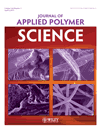Reduction in percolation threshold of injection molded high-density polyethylene/exfoliated graphene nanoplatelets composites by solid state ball milling and solid state shear pulverization
Abstract
Previous work showed that high density polyethylene (HDPE)/exfoliated graphene nanoplatelets (GNP) nanocomposites fabricated with melt extrusion followed by injection molding had a relatively high percolation threshold of between 10 and 15 vol % GNP loading. To lower the percolation threshold of injection molded HDPE/GNP nanocomposites, two special processing methods were investigated: solid state ball milling (SSBM) and solid state shear pulverization (SSSP). Results have confirmed that the percolation threshold of HDPE/GNP nanocomposites could be reduced to between 3 and 5 vol % GNP loading by these two approaches. The mechanism by which SSBM and SSSP are capable of producing lower percolation is to coat the polymer surface with GNP platelets which facilitates the formation of conductive networks during injection molding. However, it was found that HDPE/GNP nanocomposites obtained from these two techniques exhibited lower mechanical properties at high GNP loadings. © 2011 Wiley Periodicals, Inc. J Appl Polym Sci, 2012




